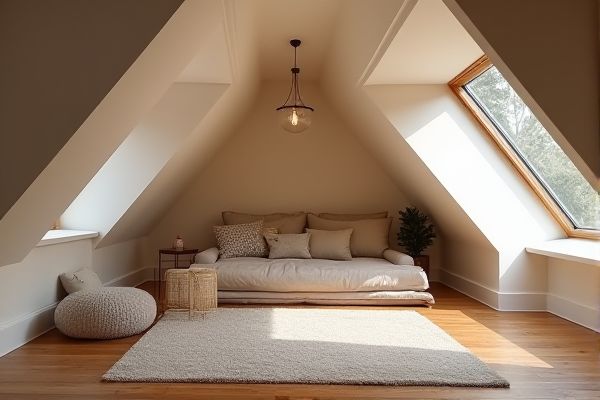
Creating an attic meditation corner offers a secluded, quiet space that minimizes distractions, enhancing deep mindfulness practices. Explore the article to discover how your living room setup compares and which environment best supports your meditation journey.
Table of Comparison
| Feature | Attic Meditation Corner | Living Room Meditation |
|---|---|---|
| Privacy | High - Secluded, minimal interruptions | Moderate - Shared space, potential distractions |
| Space | Small and cozy, can be customized | Larger, open area with versatile setup |
| Lighting | Natural light from attic windows or skylights | Varied lighting options, often artificial or mixed |
| Noise Level | Quieter, insulated from main areas | Potential for background noise from household activities |
| Accessibility | Less accessible, requires climbing stairs | Highly accessible, ground level |
| Ambience | Intimate, personalized calm space | More social, flexible environment |
| Decor Flexibility | Higher - tailored meditation aids and decor | Moderate - shared style with other living room elements |
Introduction: Choosing the Ideal Meditation Space
Creating a dedicated meditation corner in your attic offers a quiet, private retreat with minimal distractions, making it ideal for deep concentration and relaxation. In contrast, a living room meditation area provides easier accessibility and can be integrated into your daily routine, benefiting from natural light and a social atmosphere. Your choice depends on whether you prioritize solitude and tranquility or convenience and openness for your meditation practice.
The Appeal of an Attic Meditation Corner
An attic meditation corner offers a unique appeal due to its seclusion and quiet ambiance, providing an ideal environment for deep mindfulness and relaxation. The limited foot traffic and natural light filtering through skylights enhance the sense of tranquility, making it a dedicated personal sanctuary. Unlike the living room, which often serves multiple purposes, the attic space minimizes distractions, fostering greater focus and a stronger connection to meditation practices.
Benefits of a Living Room Meditation Area
A living room meditation area offers easy accessibility, encouraging consistent practice without the need for a dedicated space. Integrating meditation into your living room enhances mindfulness throughout daily activities and fosters a calming environment for both you and your family. The openness and natural light in the living room also contribute to a more uplifting and energizing meditation session.
Comparing Natural Lighting in Attic vs Living Room
Attic meditation corners often benefit from skylights or dormer windows, providing direct, abundant natural light that creates a bright and serene atmosphere ideal for mindfulness practices. In contrast, living room meditation spaces usually rely on larger, vertical windows that can offer broader but sometimes less concentrated natural lighting, influencing the room's ambiance and energy differently. The quality and positioning of natural light in attics tend to enhance focus and relaxation by minimizing distractions, whereas living rooms may require strategic arrangement to optimize sunlight exposure for meditation.
Privacy and Noise Factors in Both Spaces
An attic meditation corner offers superior privacy and reduced noise interference due to its secluded location away from main living areas, making it ideal for deep concentration and uninterrupted practice. In contrast, a living room meditation space may face more distractions from household activities and external noise, impacting the quality of your meditation sessions. Selecting an attic spot enhances tranquility, allowing you to cultivate a serene environment essential for mindfulness and relaxation.
Space Optimization: Attic vs Living Room
An attic meditation corner maximizes underutilized vertical space, offering a secluded and quiet environment ideal for focused practice without sacrificing main living areas. Living room meditation spaces require careful arrangement to avoid clutter and maintain functionality in a high-traffic zone, often demanding multifunctional furniture for seamless space optimization. Attic setups benefit from customization and minimal interference, while living rooms prioritize accessibility and integration with daily activities.
Ambiance and Personalization Opportunities
An attic meditation corner offers a secluded ambiance with natural light and cozy nooks, fostering a serene atmosphere ideal for deep relaxation. Personalization opportunities in an attic space are abundant, allowing you to tailor the environment with cushions, lighting, and decor that reflect your mindfulness journey. In contrast, a living room meditation area often shares ambient noise and activity but benefits from open space and easy access, requiring creative solutions to enhance tranquility and individual expression.
Accessibility and Convenience for Daily Practice
An attic meditation corner offers a private, quiet space that minimizes distractions, making it highly accessible for focused daily practice. In contrast, a living room meditation area provides convenience through easy access and integration with your daily routine, allowing for spontaneous sessions. Choosing Your meditation spot depends on balancing the need for seclusion with the ease of incorporating meditation into everyday life.
Pros and Cons: Attic Meditation Corner vs Living Room
An attic meditation corner offers seclusion, minimal distractions, and a cozy ambiance ideal for deep focus, but it may lack natural light and sufficient ventilation. In contrast, a living room meditation space benefits from ample light and accessibility, enhancing comfort and ease of setup, though it risks interruptions from household activities and noise. Choosing between these spaces depends on personal preference for privacy versus openness and environmental factors like lighting and noise control.
Final Thoughts: Which Space Suits Your Mindfulness Journey?
Choosing between an attic meditation corner and a living room meditation space depends on your need for privacy and ambient environment; attics often provide a secluded, quiet retreat ideal for deep mindfulness practices, while living rooms offer accessibility and comfort within active household settings. Consider factors such as natural light, noise levels, and personal routines to determine which space supports consistent meditation and mental clarity. Ultimately, aligning the meditation environment with your lifestyle fosters a sustainable and enriching mindfulness journey.
 homyna.com
homyna.com